- 1Department of Preventive Medicine, School of Public Health, Fujian Medical University, Fuzhou, China
- 2The Key Laboratory of Environment and Health, School of Public Health, Fujian Medical University, Fuzhou, China
- 3The Affiliated Fuzhou Center for Disease Control and Prevention of Fujian Medical University, Fuzhou, China
- 4School of Public Health, Anhui Medical University, Hefei, China
Background: Atmospheric oxidative pollutants, air temperature, and heatwave events pose potential threats to public health. However, the combined effects of these factors on the risk of mortality from circulatory disease remain insufficiently studied. This study aims to evaluate the synergistic effects of ozone (O₃), oxidant (Ox), and nitrogen dioxide (NO₂) with temperature and heat waves, and to explore their impact on circulatory disease mortality, providing evidence to support public health interventions.
Methods: Based on the mortality, meteorological, and environmental protection data of residents in Fuzhou City from January 1, 2016, to December 31, 2022, we employed a generalized additive model (GAM) and a distributed lag nonlinear model (DLNM) to assess the effects of atmospheric oxidative pollutants interacting with temperature and heat waves on the risk of death from circulatory diseases, where temperature includes the daily maximum temperature and diurnal temperature range (DTR). A bivariate three-dimensional model was used to visualize their synergistic effects, and stratified analyses were conducted to compare differences between heat wave and non-heat wave periods.
Results: O3, Ox, and NO2 exhibit synergistic effects with ambient temperature, and their combined exposure significantly increases the mortality risk of circulatory system diseases, myocardial infarction, and stroke, with some health effects showing a “nonlinear exposure-response relationship with an inverted U-shaped pattern.” Under heatwave conditions, the synergistic effect between NO2 and high temperatures is markedly enhanced, leading to a greater increase in mortality risk compared to O3 and Ox, and demonstrating both a same-day lag and a cumulative effect. After introducing other pollutants into the dual-pollution model, NO2 still shows a strong independent health effect on major causes of death during heatwaves, with the most pronounced risk elevation observed for stroke.
Conclusion: Atmospheric oxidative pollutants interact with high temperatures, diurnal temperature range, and heatwaves, significantly increasing the risk of mortality. It is essential to integrate air pollution and meteorological factors to strengthen health protection during high-risk periods.
1 Introduction
Against the backdrop of global climate change, extreme weather events are becoming increasingly frequent. At the same time, accelerated urbanization and industrialization are contributing to the gradual deterioration of air quality (1, 2). Numerous studies have confirmed that air pollution and extreme meteorological conditions can significantly increase population mortality and disease risks (3–8). Some research has also shown that high temperatures pose a risk for death from circulatory diseases in humans (9, 10). However, environmental exposure factors rarely occur in isolation. Atmospheric oxidative pollutants may interact in complex ways with meteorological variables like temperature and heatwaves, and the health impacts of such combined exposures have not been fully elucidated. Existing evidence indicates that rising temperatures can enhance ozone formation efficiency, and high heat may exacerbate the toxic effects of pollutants by altering human physiological responses (11, 12). Therefore, assessing the health effects of single exposure factors alone may underestimate the true public health risks.
As early as the 20th century, researchers began to investigate the combined effects of temperature and atmospheric oxidative pollutants (13). Subsequent studies have found that such interactions may lead to an increase in the morbidity risk in the population (14–16). Similarly, studies have indicated that the health effects of air pollution may be amplified under the combined action of meteorological fluctuations (16–18). In addition, some studies have focused on the combined effect of diurnal temperature range (DTR) and atmospheric oxidizing pollutants (19, 20). Research suggests that both extremely high and extremely low DTR may exacerbate health risks, and that very low DTR, in combination with fine particulate matter, may play a synergistic role in the development of chronic obstructive pulmonary disease (21), In addition, a review has systematically summarized the mechanisms by which air pollution, particularly PM, exacerbates conditions in chronic obstructive pulmonary disease (COPD) patients, further supporting the potential synergistic effects between pollutants and meteorological factors (22), suggesting that the combined effect of meteorological variability and air pollution deserves great attention.
Located on the southeast coast of China, Fuzhou is characterized by a hot and humid climate with intense sunlight. Although the overall air quality is better than that of northern cities, its unique climatic conditions may amplify the health impacts of high temperatures and oxidative pollutants. Therefore, conducting a population-based mortality risk assessment focused on the interactions between heatwaves, high temperatures, and atmospheric oxidative pollutants in Fuzhou could provide valuable scientific insights for other coastal cities.
2 Materials and methods
2.1 Data information
The data collected for this study consist of a continuous seven-year time series from January 1, 2016, to December 31, 2022, in Fuzhou City, including environmental protection data, meteorological data, and mortality data of residents.
2.1.1 Environmental protection data
The daily average concentration data of atmospheric pollutants in this study were obtained from seven national environmental monitoring stations established by the Fuzhou Environmental Monitoring Center Station, These stations are located at Fujian Normal University, Gushan, Ziyang, Kuaian, Wusi North Road, Yangqiao West Road, and the Twenty-ninth Middle School of Fuzhou City. The pollutants monitored include PM2.5 (particulate matter with a diameter < 2.5 μm), PM10 (particulate matter with a diameter < 10 μm), O3, NO2, SO2 (sulphur dioxide), and CO (carbon monoxide).
Atmospheric oxidizing capacity is used to assess the ability of atmospheric oxidants to oxidize or reduce substances. Referring to the relevant literature (23), Ox can be estimated by the hourly mass concentrations (hereinafter referred to as concentrations) of O3 and NO2. Due to the different redox potentials of O3 and NO2, different weights are assigned to the two when calculating Ox in this study. The formula for calculating Ox is as follows (Equation 1):
2.1.2 Meteorological data
Meteorological data were obtained from the Meteorological Bureau of Fuzhou City, including daily average temperature (°C), daily average atmospheric pressure (hPa), and daily average relative humidity (%).
2.1.3 Mortality data
Mortality data in this study were obtained from the Fuzhou Center for Disease Control and Prevention, based on joint reporting from public security, civil affairs, and other relevant departments. Daily death counts were classified according to the underlying cause of death based on the “International Classification of Diseases, the 10th Edition (ICD-10).” The categories included deaths from circulatory system diseases (I00–I99), myocardial infarction (I21), and stroke (I64).
2.2 Statistical analysis
This study employed a bivariate three-dimensional model and stratified analysis to assess the interactive effects of atmospheric oxidative pollutants and temperature on mortality risk among residents. The bivariate three-dimensional model was used to visualize the joint effects of oxidative pollutants and temperature, providing an intuitive representation of their relationship with mortality risk. Stratified analysis was conducted to evaluate the effects of pollutants separately during heatwave and non-heatwave periods, to explore variations under different meteorological conditions.
2.2.1 Bivariate three-dimensional model of oxidative pollutants and heatwaves
In this study, thin plate regression splines (TPS) were first used to visualize the interactive effects of temperature and atmospheric oxidative pollutants on mortality risk. Subsequently, temperature and atmospheric oxidative pollutants were included as continuous bivariate predictors in a GAM to generate a three-dimensional surface plot illustrating their relationships with the outcome variable. Considering the lagged effect of atmospheric oxidative pollutants on health outcomes, the pollutant concentrations in the model used the moving average with a lag of L days (lag0-L), where the value of L was determined based on the lag effect analysis. The model formula is as follows:
In this equation, TS represents TPS, TS(PtL, Tempt) represents the interaction term between atmospheric oxidizing pollutants and temperature, PtL is the moving average of atmospheric oxidizing pollutant day L on day t, Tempt is the daily average temperature on day t, and others are as in Equation 1.
2.2.2 Interaction model of oxidizing pollutants and heatwaves
This study focused exclusively on periods during which heatwaves were likely to occur, limiting the analysis to the summer months (May to October) from 2016 to 2022. According to the World Meteorological Organization (WMO) definition, a heatwave is identified when the daily maximum temperature exceeds 32°C for three consecutive days (24). To examine the interactive effect between atmospheric oxidizing pollutants and heatwaves, we employed a GAM. The effects of oxidative pollutants on mortality risk are assessed separately during heatwave and non-heatwave periods. The model also adjusted for long-term time trends, short-term fluctuations, and potential confounding effects of other meteorological factors. The model formula is as follows:
In this equation, E (Yt) is the expected value of the number of deaths on day t, Zt is the oxidizing pollutant on day t, β is the exposure-response coefficient, HK denotes a dummy variable for heatwave (H1 = 0, H2 = 0) and non-heatwave days (H1 = 0, H2 = 0), β1 and β2 represent the effects of oxidizing pollutants in the heatwave layer and the non-heatwave layer respectively, Xt is the meteorological factor on day t of the observation, including the average relative humidity, and others as in Equation 1.
2.3 Quality control
This study employed dedicated data management personnel responsible for the collection and quality control of mortality, environmental, and meteorological monitoring data. The personnel were required to be familiar with the data collection content and related workflows, including data acquisition, quality review, and online submission. All collected data had to be accurate, with complete geographic coverage and comprehensive variables. In particular, key variables such as date of death, cause of death, and ICD codes were required to be fully documented. Rigorous verification of reported data was conducted to eliminate duplicate, erroneous, or redundant records, as well as data from days with abnormally high or low death counts, to ensure data quality and the accuracy of the analysis.
3 Results
3.1 Bivariate model results for the effects of O3, Ox, NO2 and temperature on mortality
3.1.1 Bivariate model results for the effects of O3, Ox, NO2 and daily maximum temperature on mortality
Visualization of O3, Ox, NO2, and May–October daily maximum temperature with the risk of death from circulatory system diseases, myocardial infarction, and stroke (Figure 1), the results showed that increases in O3 and Ox concentrations, along with rising daily maximum temperatures, were associated with an upward trend in mortality risk for all three causes of death. This suggests that the combined exposure to daily maximum temperature and oxidative pollutants may have a greater impact on mortality than the independent effects of each factor alone. Further observation revealed that deaths from circulatory system diseases and myocardial infarction increased markedly with rising NO2 concentrations and daily maximum temperatures, with the mortality effects peaking when both NO2 levels and daily maximum temperatures were at their highest. These findings indicate a possible synergistic effect between NO2 and high temperatures, posing a heightened health threat for specific diseases.
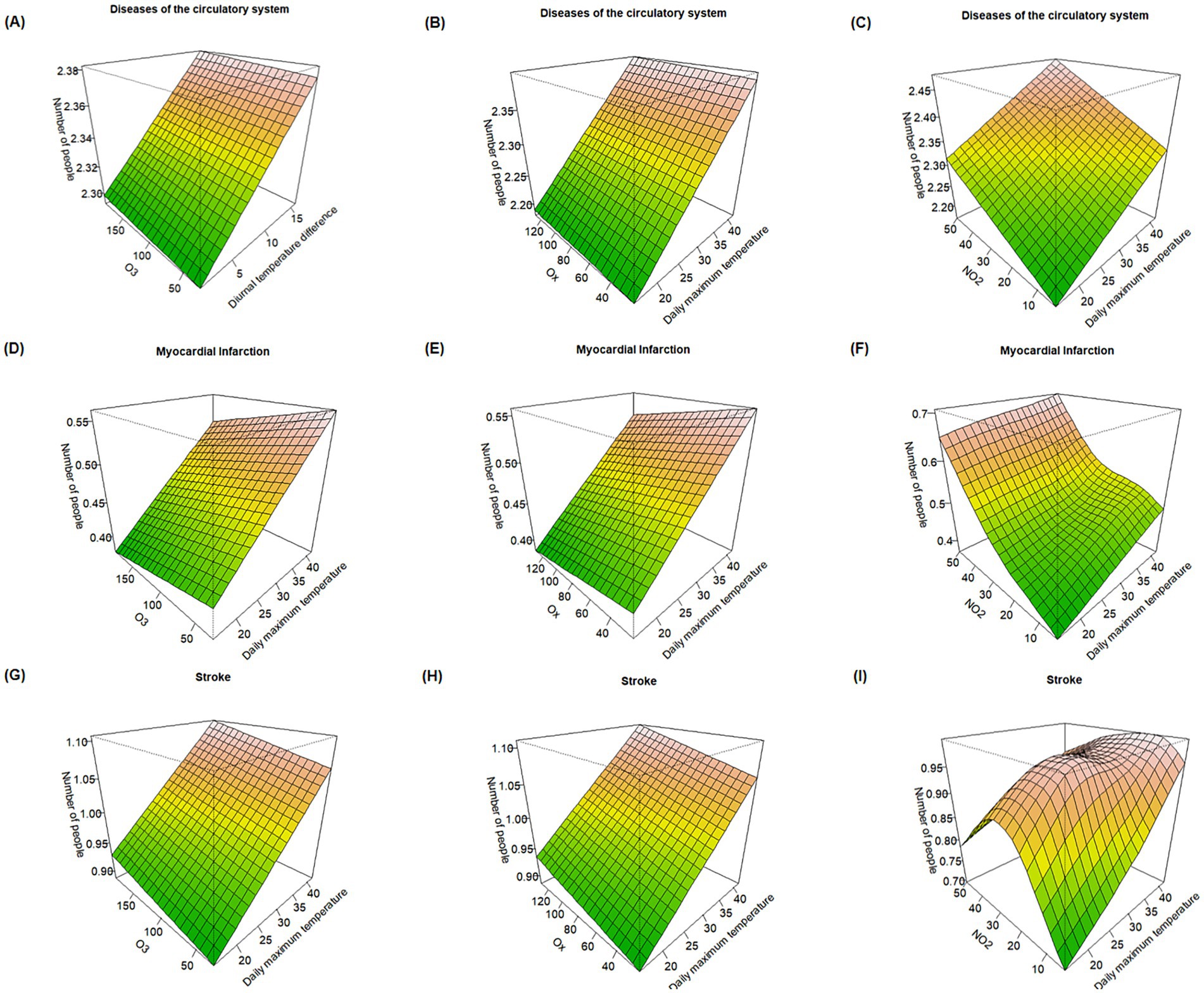
Figure 1. Response surface plots of the effects of O3, Ox, and NO2 combined with daily maximum temperature on major causes of death. (A–C) Effect of O3, Ox, and NO2 combined with daily maximum temperature on mortality risk from circulatory system diseases. (D–F) Effect of O3, Ox, and NO2 combined with daily maximum temperature on mortality risk from myocardial infarction. (G–I) Effect of O3, Ox, and NO2 combined with daily maximum temperature on mortality risk from stroke.
In addition, the interactive effects between atmospheric oxidative pollutants and daily maximum temperature exhibited differentiated health impacts across various causes of death. While the effects of O3 and Ox on mortality from circulatory system diseases, myocardial infarction, and stroke followed similar overall trends, the dominant influencing factors varied. For circulatory system and stroke mortality, daily maximum temperature was the primary driver. In contrast, NO2 showed a significant leading effect on myocardial infarction mortality, with risk increasing as NO2 concentration rose. Notably, the interaction effect between NO2 and daily maximum temperature presents some health effects showing a “nonlinear exposure-response relationship with an inverted U-shaped pattern.” That is to say, when the concentration of NO2 approaches 30 μg/m3, the combined effect with high temperature is the strongest, and it has the greatest impact on the mortality risk of stroke among residents.
3.1.2 Bivariate model results for the effects of O3, Ox, NO2 and DTR on mortality
Figure 2 presents bivariate three-dimensional surface plots illustrating the effects of O3, Ox, NO2, and DTR from May to October on deaths due to circulatory system diseases, myocardial infarction, and stroke. The plots show that when O3 and Ox concentrations, as well as DTR, reached their highest levels, deaths from circulatory system diseases and stroke also peaked. This suggests that the combined effect of DTR with O3 and Ox may exceed their individual impacts in triggering mortality from these two conditions. Additionally, when both NO2 concentration and DTR increased, the response surface for circulatory system disease mortality exhibited an upward trend, indicating that their joint effect may elevate the mortality risk. As for myocardial infarction, the combined effects of O3, Ox, and NO2 with DTR showed that mortality risk generally rose with increasing pollutant concentrations. However, interestingly, higher DTR was associated with fewer deaths, suggesting a potential inverse relationship in this context.
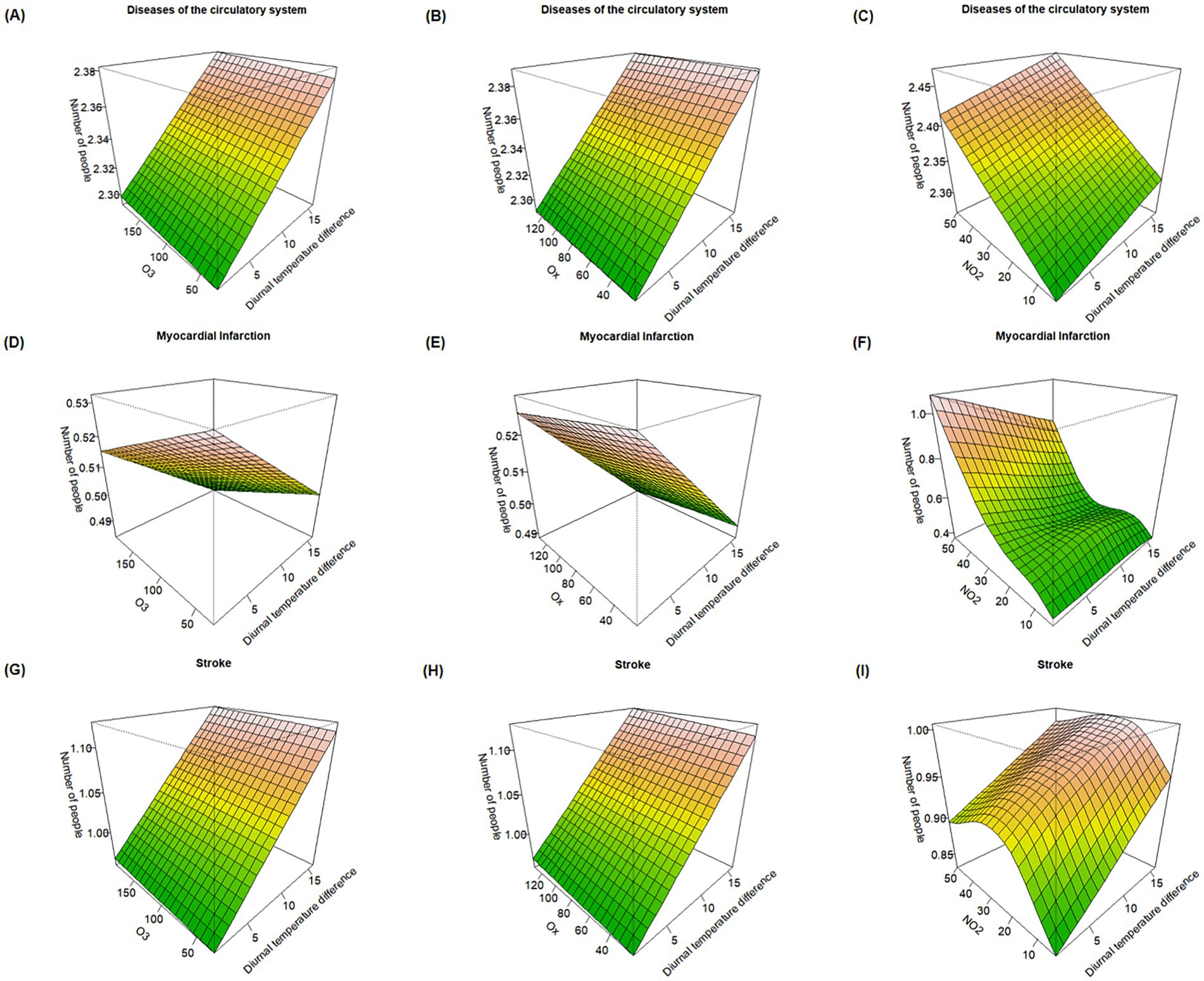
Figure 2. Response surface plots of the effects of O3, Ox, and NO2 combined with DTR on major causes of death. (A–C) Effect of O3, Ox, and NO2 combined with DTR on mortality risk from circulatory system diseases. (D–F) Effect of O3, Ox, and NO2 combined with DTR on mortality risk from myocardial infarction. (G–I) Effect of O3, Ox, and NO2 combined with DTR on mortality risk from stroke.
The interactions between different atmospheric oxidative pollutants and DTR demonstrated varying effects across different diseases. For mortality from circulatory system diseases and stroke, DTR appeared to be the dominant factor in the interaction effects. In contrast, for myocardial infarction, O3 and Ox played the primary roles, with risk decreasing as the concentrations of O3 and Ox increased. In the interaction between NO2 and DTR, NO2 concentration emerged as the dominant factor influencing circulatory system diseases and myocardial infarction death. Additionally, the interaction effect between NO2 and DTR varied in awith some health effects showing a “nonlinear exposure-response relationship with an inverted U-shaped pattern,” with the largest effect of the interaction with DTR at about 30 μg/m3, which corresponded to the highest number of stroke deaths in the population.
3.2 Interaction effects of atmospheric oxidizing pollutants and heatwaves on residential mortality
3.2.1 Results of the bivariate model of the effects of atmospheric oxidizing pollutants and heatwaves on residential mortality
As shown in Figure 3, under heatwave temperature conditions, the joint effects of O3 and Ox concentrations with temperature on circulatory system disease risk follow a similar upward trend as observed under general daily maximum temperature conditions. However, for stroke mortality, the risk appears to vary only with changes in O3 and Ox concentrations, suggesting that under heatwave conditions, the interaction between temperature and these pollutants no longer significantly influences stroke mortality. Moreover, in the interaction between O3, Ox, and temperature on circulatory system disease mortality, temperature emerges as the dominant contributing factor.

Figure 3. Response surface plots of the effects of O3, Ox, and NO2 combined with temperature on major causes of death during heatwave periods. (A–C) Effect of O3, Ox, and NO2 combined with temperature on mortality risk from circulatory system diseases. (D–F) Effect of O3, Ox, and NO2 combined with temperature on mortality risk from myocardial infarction. (G–I) Effect of O3, Ox, and NO2 combined with temperature on mortality risk from stroke.
When both NO2 concentration and temperature increase simultaneously, the number of deaths from circulatory system diseases, myocardial infarction, and stroke among residents shows an upward trend. This suggests that under heatwave conditions, the combined effect of NO2 and temperature on mortality may exceed the effects of either factor alone.
Compared to heatwave days, under non-heatwave temperature conditions (as shown in Figure 4), the mortality effect of stroke reaches its peak when both O3 or Ox concentrations and temperature are at their highest, implying that on non-heatwave days, the combined impact of temperature and O3 and Ox may exert a stronger influence on stroke mortality. Overall, however, the mortality effects observed during heatwaves are higher than those on non-heatwave days, suggesting that heatwave events can exacerbate the effects of oxidizing pollutants on the risk of residential mortality.
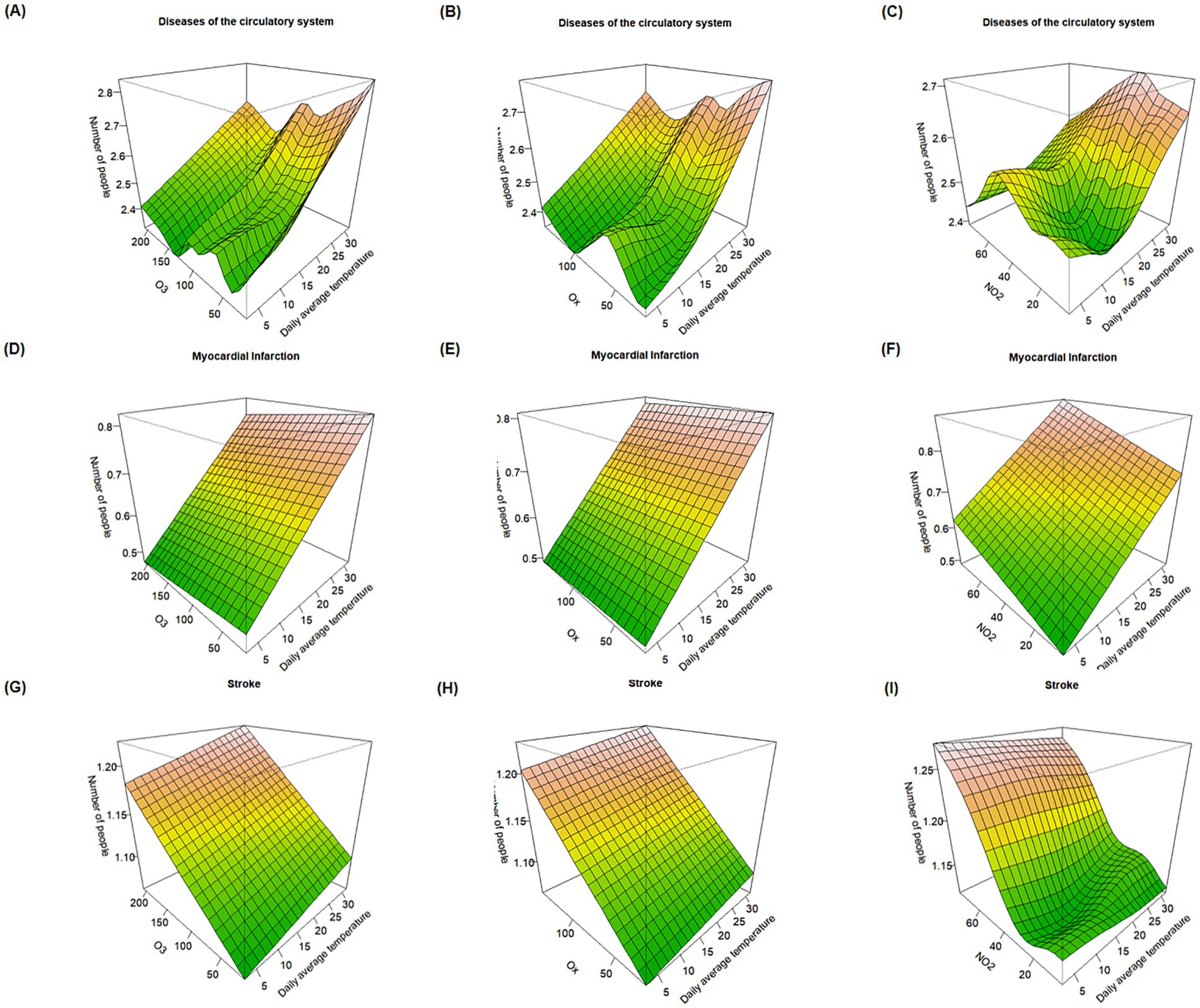
Figure 4. Response surface plots of the effects of O3, Ox, and NO2 combined with temperature on major causes of death during non-heatwave periods. (A–C) Effect of O3, Ox, and NO2 combined with temperature on mortality risk from circulatory system diseases. (D–F) Effect of O3, Ox, and NO2 combined with temperature on mortality risk from myocardial infarction. (G–I) Effect of O3, Ox, and NO2 combined with temperature on mortality risk from stroke.
3.2.2 Effects of the interaction between atmospheric oxidative pollutants and heatwaves on the excess mortality of major causes of death
During heatwaves, each 10 μg/m3 increase in concentrations of O3, Ox, and NO2 was associated with both a lagged effect of the day (lag0) and a persistent cumulative effect (lag0–7) excess mortality effects on circulatory system diseases, myocardial infarction, and stroke, as shown in Figure 5. Further analysis of the lag0 day effect revealed that the health risks associated with NO2 during heatwave periods were the most pronounced, exceeding those of O3 and Ox. Table 1 also presents a comparison between the results of this study and those reported in previous literature, suggesting that NO2 may exhibit a stronger independent health effect under high-temperature conditions. To assess the robustness of the heatwave definition, a sensitivity analysis using an alternative threshold of 32°C lasting for two consecutive days was performed, and the results are presented in Supplementary Table S1. The findings were consistent with the main analysis, indicating the stability of the observed effects.
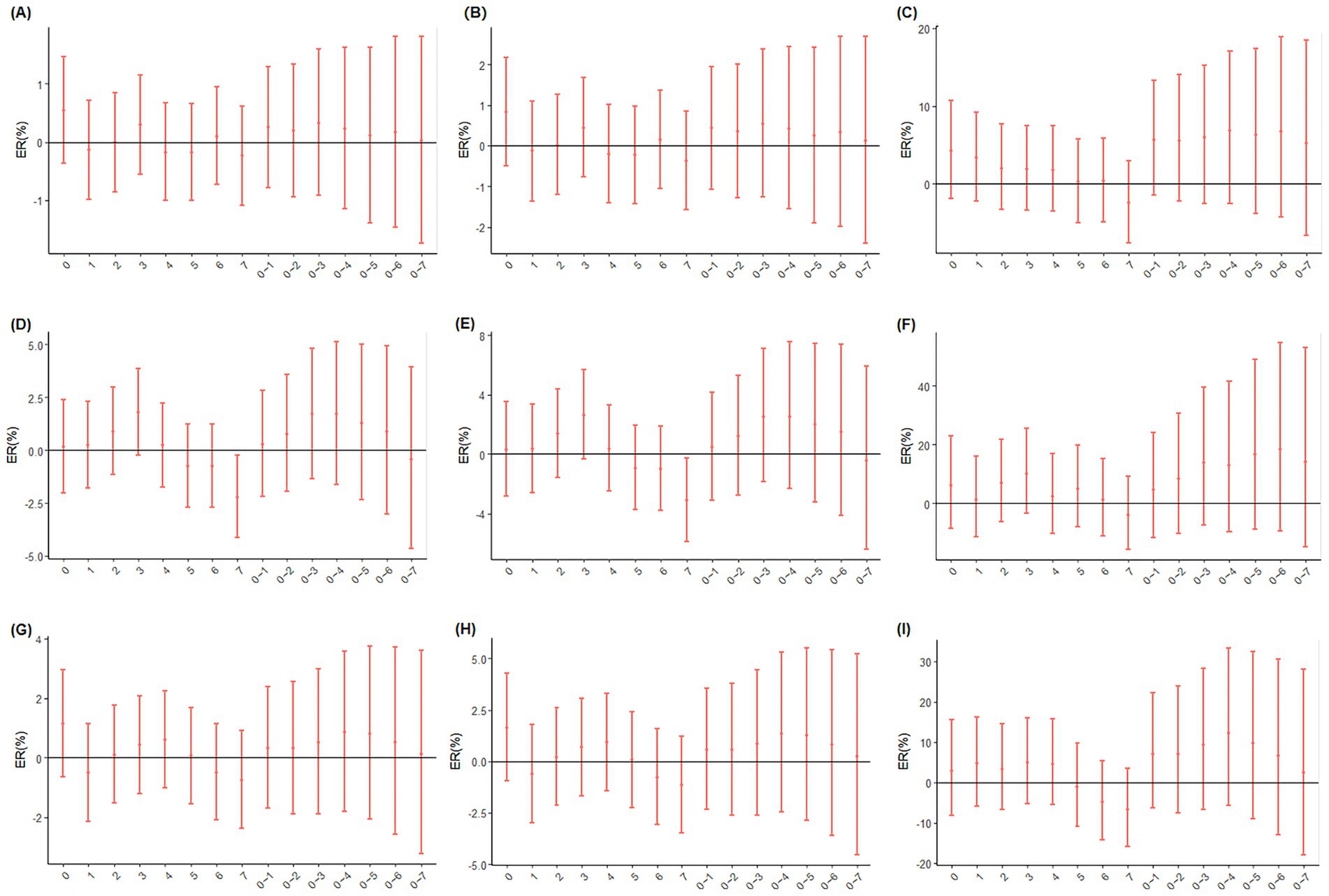
Figure 5. Excess risk for major causes of death associated with each 10 μg/m3 increase in O3, Ox, and NO2 concentrations during heatwave days (ER: Excess Risk and 95% CI: 95% Confidence Interval). (A–C) Effect of each 10 μg/m3 increase in O3, Ox, and NO2 on the risk of circulatory system disease mortality among residents. (D–F) Effect of each 10 μg/m3 increase in O3, Ox, and NO2 on the risk of myocardial infarction mortality among residents. (G–I) Effect of each 10 μg/m3 increase in O3, Ox, and NO2 on the risk of stroke mortality among residents.

Table 1. Stratified analysis of the impact of each 10 μg/m3 increase in O3, Ox, and NO2 on excess risk among residents, with the heatwave definition of ≥32°C for ≥3 consecutive days (ER and 95% CI).
3.3 Fitting results of the two-pollutant model for the interaction between atmospheric oxidative pollutants and heatwaves
Based on the lag day with the highest excess risk (ER), additional pollutants were introduced to construct two-pollutant models. The results showed that, after adjusting for PM2.5, PM10, SO2, and CO during non-heatwave periods, the effects of atmospheric oxidative pollutants on the mortality risks of circulatory system diseases, myocardial infarction, and stroke were not statistically significant (p > 0.05). However, during heatwave periods, the single-pollutant models for O3 and Ox indicated a positive association with increased risk of myocardial infarction mortality, with ER values (95% CI) of 0.15 (−2.02, 2.37) and 0.30 (−2.83, 3.54), respectively. After incorporating PM2.5, PM10, SO2, and CO into the two-pollutant models, the effects of O3 and Ox on myocardial infarction mortality were attenuated. This attenuation may be attributed to reduced outdoor activity during extreme heat, thus reducing the actual exposure to air pollutants.
In addition, within the two-pollutant models for NO2, its effects on mortality from circulatory system diseases, myocardial infarction, and stroke were significantly stronger than those of O3 and Ox. In particular, the ER (95% CI) of the effect of the two-pollutant model of NO2 and PM10 on stroke deaths was 4.84 (−12.00, 24.90), with a peak value nearly 8 times greater than that of O3 (2.29) or Ox (3.54). Detailed results are presented in Tables 2–4.
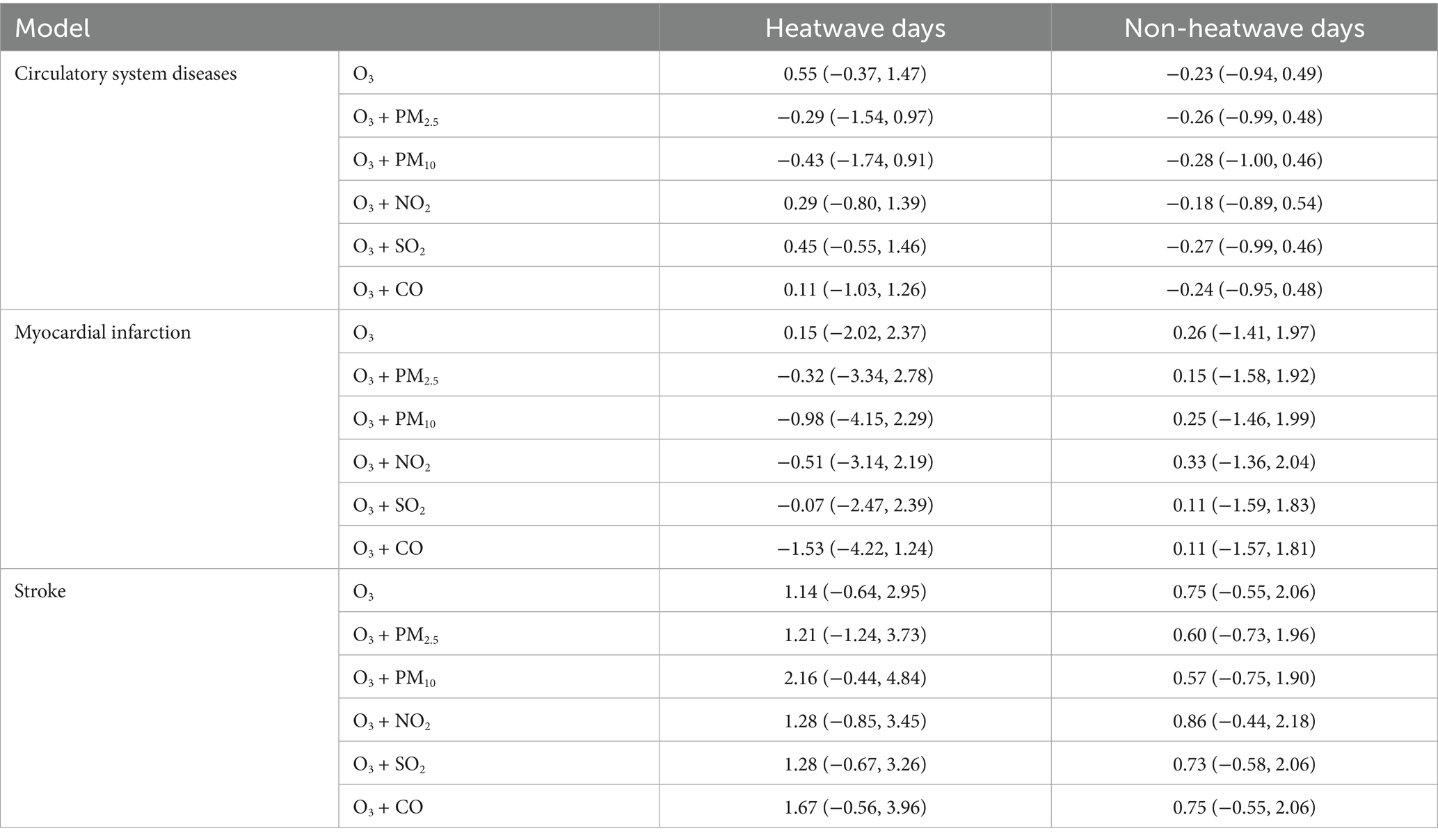
Table 2. Two-pollutant model for the effect of each 10 μg/m3 increase in O3 on the excess mortality risk of the major causes of death among residents (ER and 95% CI).
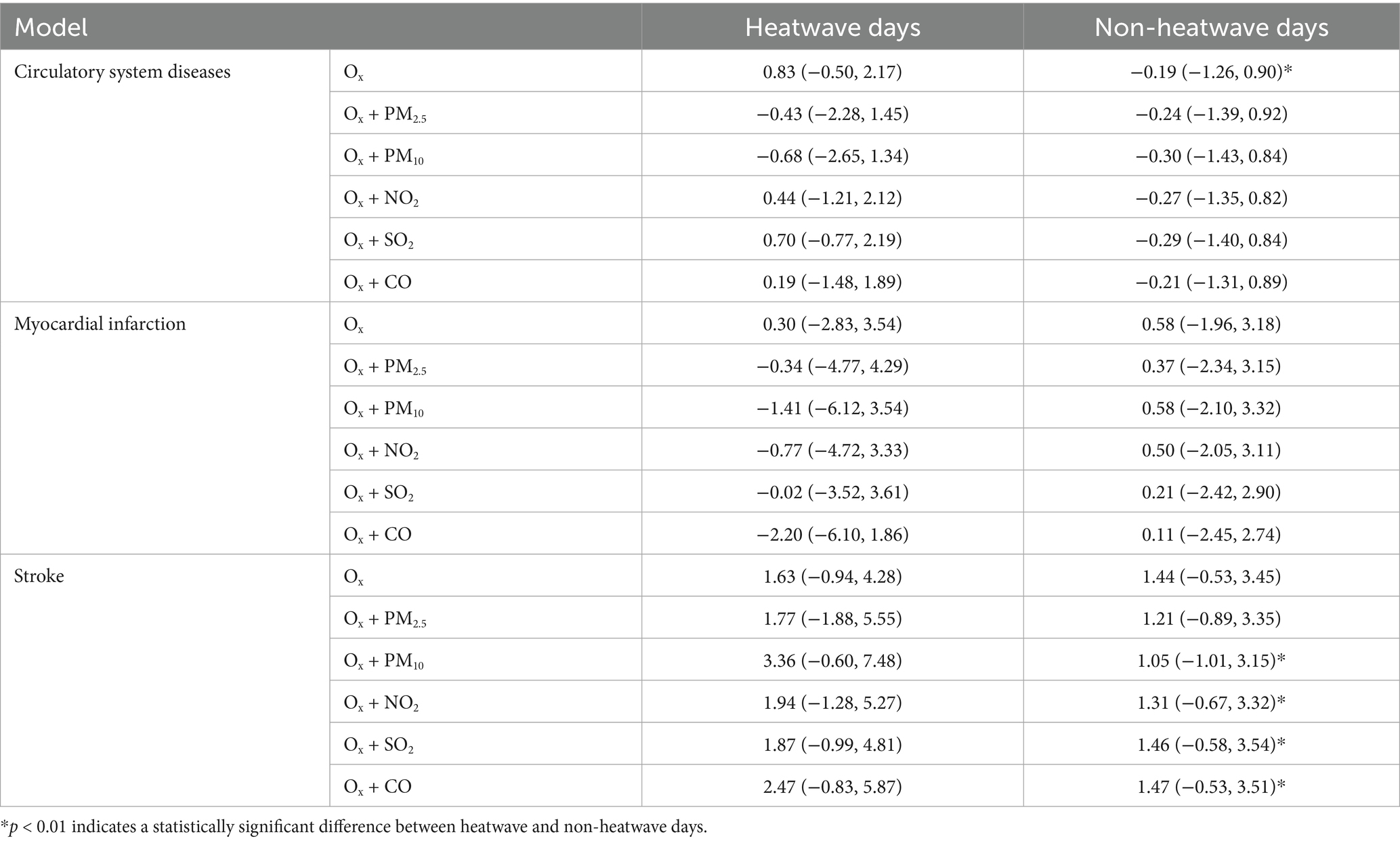
Table 3. Two-pollutant model for the effect of each 10 μg/m3 increase in Ox on the excess mortality risk of the major causes of death among residents (ER and 95% CI).
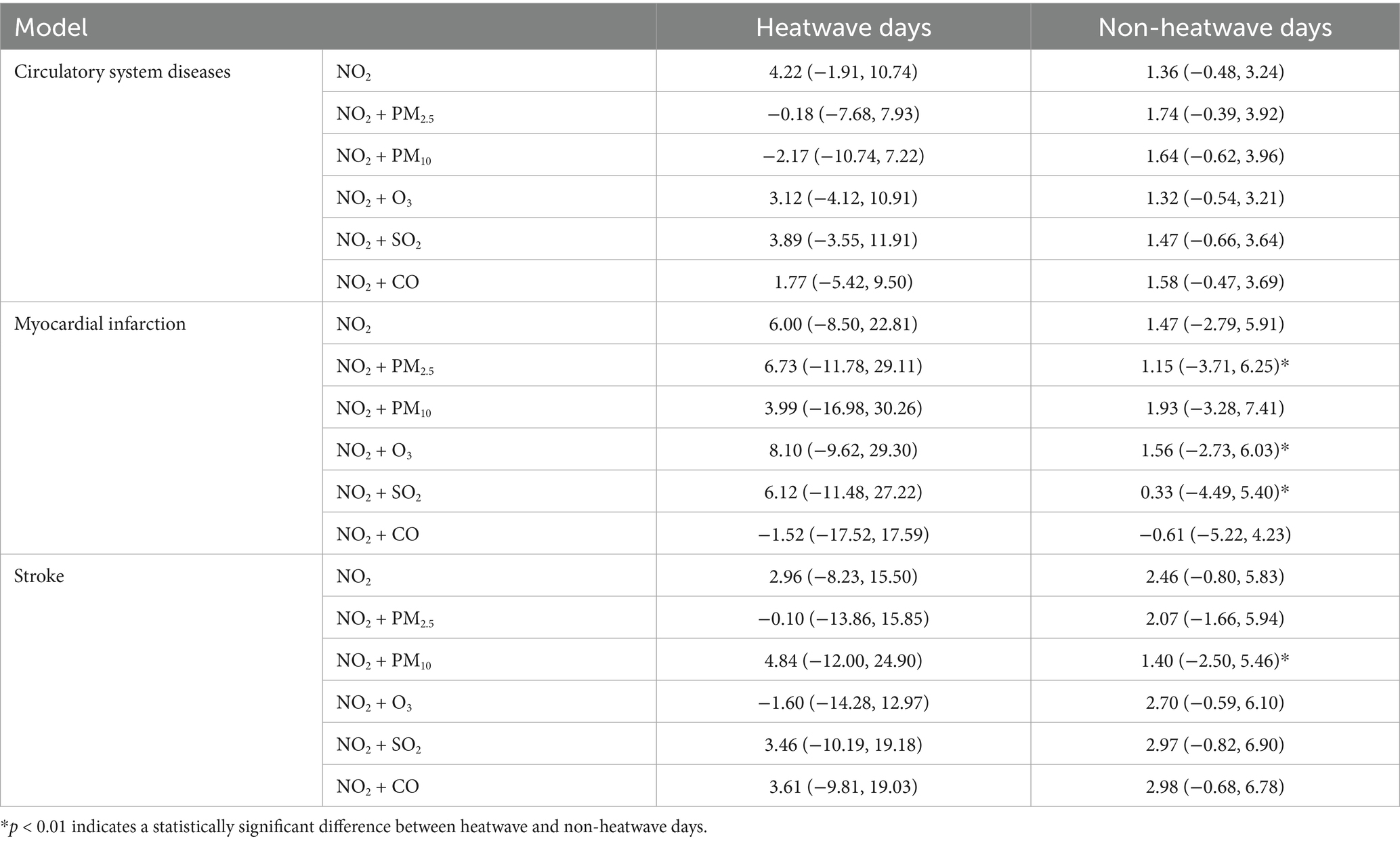
Table 4. Two-pollutant model for the effect of each 10 μg/m3 increase in NO2 on the excess mortality risk of the major causes of death among residents (ER and 95% CI).
4 Discussion
4.1 Synergistic effects of O3, Ox, and temperature on circulatory system mortality
This study found that simultaneous increases in daily maximum temperature and O3 concentrations were significantly associated with elevated mortality from circulatory system diseases, myocardial infarction, and stroke. These findings suggest a potential synergistic health effect between O3 and high temperatures, which is consistent with previous research. For example, one study reported that on high-ozone days, a 1°C increase in temperature was associated with a 2.20% rise in daily total mortality (25). In addition, diurnal temperature range (DTR), an indicator of intraday temperature fluctuation, was incorporated into our analysis to assess its joint effects with O3 and Ox. The results indicated that these interactive effects were particularly pronounced in stroke-related mortality. While limited epidemiological evidence currently exists regarding the interaction between DTR and O3, our study provides novel insights into this area.
From a biological perspective, O3 may exacerbate cardiovascular burden through multiple mechanisms, including the activation of oxidative stress pathways, promotion of systemic inflammation, induction of myocardial ischemia, and impairment of endothelial function (26, 27). These mechanisms provide a plausible explanation for the amplified health risks observed under conditions of high temperature or significant temperature variability.
Regarding Ox, which reflects the combined oxidant burden of ozone and NO2 (28), our findings demonstrated that elevated Ox levels in conjunction with high temperature and DTR significantly increased the risk of circulatory system and stroke-related mortality. This may be attributed to the toxicological effects of NOx compounds (29). Notably, most previous studies have focused on the relationship between NOx and daily mean temperature (30, 31). In contrast, this study introduces DTR as an indicator of temperature variability and reveals that its interaction with Ox has a more pronounced impact on health under thermally unstable conditions. This finding adds methodological innovation and real-world significance to the current literature.
4.2 The impact of O3 and Ox in combination with heatwaves on circulatory mortality
During heatwave periods, the synergistic effects between elevated concentrations of O3, Ox, and high ambient temperatures further amplified the mortality risks from circulatory system diseases and myocardial infarction, suggesting a compounded health burden driven by their interaction. This finding is consistent with previous research (32–34). Studies have indicated that under extreme heat conditions, individuals experience rapid fluctuations in heart rate, blood pressure, and blood volume, which heighten their susceptibility to air pollutants (35). Moreover, heatwaves are often accompanied by intense solar radiation that promotes photochemical reactions, thereby increasing ambient O3 levels and further exacerbating health risks (34).
Notably, our study also observed differential effects of O3 and Ox on various causes of death. The impact was particularly significant for myocardial infarction, while the effect on stroke appeared weaker. These differences may be attributed to variations in disease pathophysiology, organ-specific susceptibility, and the timing of exposure windows. Further analysis revealed that extreme weather events may shift the dominant drivers of health risk. During non-heatwave periods, temperature emerged as the primary determinant, whereas during heatwaves, pollutant levels became the leading contributors to mortality. This dynamic shift in the primary influencing factor highlights the complex coupling between meteorological variables and air pollutants under extreme climate conditions. It underscores the need to incorporate these interactions into future climate adaptation strategies and public health early warning systems.
4.3 Synergistic effects of NO2 with temperature and its independent contribution
NO2 exhibited more pronounced health effects than O3 and Ox in this study, especially under high-temperature conditions and when the DTR was large. Under elevated temperatures, pollutants like NO2 can more easily penetrate the respiratory system and enter the bloodstream, triggering systemic inflammation and endothelial dysfunction (36). Additionally, NO2 may activate the sympathetic nervous system, potentially leading to arrhythmias or acute cardiovascular events. Moreover, the interaction between NO2 and large DTR suggests that sharp intra-day temperature swings can weaken physiologic adaptation to environmental stressors, thereby magnifying the toxic effect of NO2 (37, 38). Importantly, two-pollutant models showed that the NO2-related risks remained significant after adjusting for CO, PM2.5, and O3, indicating that NO2 acts as an independent hazard rather than merely serving as a proxy for overall traffic-related pollution. This result provides empirical support for prioritizing NO2 monitoring and targeted interventions in refined pollution-control strategies. To design still more accurate public-health measures, future studies should elucidate the molecular pathways that underlie the interaction between NO2 and various temperature metrics.
4.4 Amplified interaction between NO2 and heatwaves on circulatory mortality
During heatwaves, the amplifying effect of NO2 on the mortality risk of myocardial infarction was significantly enhanced, suggesting a heightened health sensitivity under extreme weather conditions. Our study found that the NO2-related risk of myocardial infarction mortality was markedly higher on heatwave days compared to non-heatwave periods. Notably, this association remained statistically significant in two-pollutant models after controlling for other co-pollutants, indicating that the observed effect may not simply reflect confounding by heat or coexisting pollutants but may instead point to an independent health effect of NO2 itself. In contrast, during non-heatwave periods, although the ER estimate for myocardial infarction in the NO2 and O3 two-pollutant model was the highest (ER = 8.10, 95% CI: −9.62, 29.30), it was not statistically significant—potentially due to limited sample size—highlighting the need for larger-scale studies to confirm the consistency and robustness of this trend.
From a behavioral exposure perspective, heat waves often lead to increased window ventilation and outdoor activity, unintentionally elevating actual NO2 exposure. On the atmospheric chemistry level, high temperatures and ultraviolet radiation accelerate NO2 photolysis and promote ozone formation (39, 40). As such, NO2 acts both as a precursor to and a product of ozone, engaging in complex nonlinear interactions that intensify under high-temperature conditions—thereby amplifying the health burden of combined pollution exposure.
In the context of increasingly frequent heatwaves, special attention should be paid to the joint exposure risks of NO2 and high temperatures, and enhanced control strategies are urgently needed. We recommend multi-tiered interventions during heatwaves, such as restricting high-emission vehicles, optimizing urban traffic flows, improving air purification in public spaces, and strengthening public guidance on protective behaviors, to effectively mitigate the cardiovascular risks arising from the interaction between NO2 and extreme heat.
4.5 Strengths and limitations of the study
This study presents several strengths and limitations, offering valuable insights for future research and methodological improvements. First, it is based on 7 years of comprehensive mortality data from the general population in Fuzhou and employs both GAM and DLNM to systematically evaluate the nonlinear and lagged effects of air pollutants and meteorological factors, enabling a more robust analysis. Second, by incorporating the interaction between Ox and DTR under a subtropical coastal climate, the study expands the regional evidence base for the “heat–oxidant synergy” hypothesis on circulatory system health. Third, the use of two-pollutant models provides further validation of the independent health effect of NO2, offering scientific support for refining pollutant-specific regulatory strategies and developing targeted public health interventions during heatwaves.
However, some limitations should be acknowledged. Firstly, several ER estimates had wide confidence intervals, and certain results did not reach statistical significance, possibly due to limited sample size. Future studies with larger datasets are needed to confirm the stability of these findings. Secondly, exposure assessment relied on average concentrations from fixed monitoring stations, which may not accurately capture individual-level exposure, especially during heatwave conditions when indoor–outdoor temperature differences may be substantial. Additionally, the models did not account for potential confounding factors such as socioeconomic status, pre-existing health conditions, or individual behavior, which may have influenced the exposure–response relationships. Future research could benefit from incorporating high-resolution exposure data and individual-level health records to enhance analytical precision.
5 Conclusion
This study, drawing on city-wide mortality records for Fuzhou from 2016 to 2022, systematically evaluated how atmospheric oxidative pollutants (O3, Ox and NO2) interact with meteorological factors—including daily maximum temperature, heat-waves and DTR—to influence deaths from circulatory system diseases, myocardial infarction and stroke. We found pronounced synergistic effects between O3, Ox, and both high temperature and DTR: combined exposure produced substantially higher health risks than either pollutant or weather variable alone, and the interaction patterns as well as the dominant driving factors differed by pollutant. O3 and Ox were most strongly linked to stroke mortality under large DTR, suggesting that sharp within-day temperature swings may impair physiological adaptation and amplify oxidative-stress pathways. By contrast, NO2 showed the greatest effect modification under high-temperature and heat-wave conditions, with a particularly strong impact on myocardial-infarction mortality. Two-pollutant models confirmed NO2’s independent health effect; its risk estimates remained significant after adjusting for other pollutants, indicating that NO2 is not merely a proxy for traffic emissions but likely exerts direct toxic effects.
Moreover, the impact of NO2 during heat waves was markedly stronger than on non-heat-wave days, underscoring heightened exposure sensitivity during extreme weather and NO2’s elevated cardiovascular hazard under high-temperature scenarios. The photochemical production and transformation of O3 and NO2 in hot conditions create complex, nonlinear pollutant–weather interactions that further intensify population-level health risks.
This study enhances our understanding that pollutants and climatic factors do not act in isolation on human health but often interact to produce compounded adverse effects. Therefore, strategies aimed at preventing and controlling the health hazards of air pollution must also consider the synergistic impact of adverse weather conditions, particularly in the context of climate change and the increasing frequency of extreme heat events.
Data availability statement
The raw data supporting the conclusions of this article will be made available by the authors, without undue reservation.
Author contributions
WW: Writing – review & editing, Writing – original draft. YC: Writing – review & editing. RL: Writing – review & editing. LY: Writing – review & editing. YJ: Writing – review & editing. JX: Writing – review & editing. JW: Writing – review & editing. JL: Writing – review & editing. BL: Writing – review & editing. HL: Writing – review & editing. CW: Writing – review & editing.
Funding
The author(s) declare that financial support was received for the research and/or publication of this article. This work was supported by the Upper-level Program of Natural Science Foundation of Fujian Province (grant number 2021J01722), Fujian Medical University (grant numbers XRCZX2021008 and Y21014), and the Open Project Fund for Key Laboratory of Environment and Health in Fujian Universities and Colleges (grant number GWGXZD-202301).
Acknowledgments
The authors express their gratitude to friends and teachers for their invaluable support and assistance throughout this study.
Conflict of interest
The authors declare that the research was conducted in the absence of any commercial or financial relationships that could be construed as a potential conflict of interest.
Generative AI statement
The author(s) declare that no Gen AI was used in the creation of this manuscript.
Publisher’s note
All claims expressed in this article are solely those of the authors and do not necessarily represent those of their affiliated organizations, or those of the publisher, the editors and the reviewers. Any product that may be evaluated in this article, or claim that may be made by its manufacturer, is not guaranteed or endorsed by the publisher.
Supplementary material
The Supplementary material for this article can be found online at: https://www.frontiersin.org/articles/10.3389/fpubh.2025.1629857/full#supplementary-material
Abbreviations
O3, Ozone; Ox, Oxidant; NO2, Nitrogen Dioxide; GAM, Generalized Additive Model; DLNM, Distributed Lag Nonlinear Model; DTR, Diurnal Temperature Range; PM2.5, Particulate Matter with a diameter < 2.5 μm; PM10, Particulate Matter with a diameter < 10 μm; SO2, Sulphur Dioxide; CO, Carbon Monoxide; ICD-10, International Classification of Diseases, the 10th Edition; TPS, Thin plate regression splines; ER, Excess Risk; CI, Confidence Interval.
References
1. Linking urbanization and air quality together: a review and a perspective on the future sustainable urban development. J Clean Prod. (2022) 346:130988. doi: 10.1016/j.jclepro.2022.130988
2. Zhang, L, You, S, Zhang, M, Zhang, S, Yi, S, and Zhou, B. The effects of urbanization on air pollution based on a spatial perspective: evidence from China. Front Environ Sci. (2022) 10:1058009. doi: 10.3389/fenvs.2022.1058009
3. Liang, Y, Sun, Z, Hua, W, Li, D, Han, L, Liu, J, et al. Spatiotemporal effects of meteorological conditions on global influenza peaks. Environ Res. (2023) 231:116171. doi: 10.1016/j.envres.2023.116171
4. De Guzman, RB, Malik, M, Singh, N, Ho-Fung Loong, H, and Mohan, A. Lung cancer in Asia: the impact of climate change. EClinicalMedicine. (2024) 74:102680. doi: 10.1016/j.eclinm.2024.102680
5. Psistaki, K, Richardson, D, Achilleos, S, Roantree, M, and Paschalidou, AK. Assessing the impact of climatic factors and air pollutants on cardiovascular mortality in the eastern Mediterranean using machine learning models. Atmos. (2025) 16:325. doi: 10.3390/atmos16030325
6. Weiss, J. Short-term effects of extreme heat, cold, and air pollution episodes on excess mortality in Luxembourg. Int J Environ Res Public Health. (2025) 22:376. doi: 10.3390/ijerph22030376
7. Kamarehei, B, Farhadi, M, Sabzehzari, M, Sepahvand, A, Hayatolgheib, F, Bayat, M, et al. Short-term and long-term exposure to particles and their consequences in Poldokhtar City (Iran). Toxicol Rep. (2024) 13:101770. doi: 10.1016/j.toxrep.2024.101770
8. Seihei, N, Farhadi, M, Takdastan, A, Asban, P, Kiani, F, and Mohammadi, MJ. Short-term and long-term effects of exposure to PM10. Clin Epidemiol Glob Health. (2024) 27:1611. doi: 10.1016/j.cegh.2024.101611
9. Alahmad, B, Khraishah, H, Royé, D, Vicedo-Cabrera, AM, Guo, Y, Papatheodorou, SI, et al. Associations between extreme temperatures and cardiovascular cause-specific mortality: results from 27 countries. Circulation. (2023) 147:35–46. doi: 10.1161/CIRCULATIONAHA.122.061832
10. Singh, N, Areal, AT, Breitner, S, Zhang, S, Agewall, S, Schikowski, T, et al. Heat and cardiovascular mortality: an epidemiological perspective. Circ Res. (2024) 134:1098–112. doi: 10.1161/CIRCRESAHA.123.323615
11. Chen, B, Zhen, L, Wang, L, Zhong, H, Lin, C, Yang, L, et al. Revisiting the impact of temperature on ground-level ozone: a causal inference approach. Sci Total Environ. (2024) 953:176062. doi: 10.1016/j.scitotenv.2024.176062
12. He, M, Liu, H, Fang, Z, He, B, and Li, B. High-temperature and thermal radiation affecting human thermal comfort and physiological responses: an experimental study. J Build Eng. (2024) 86:108815. doi: 10.1016/j.jobe.2024.108815
13. Goldstein, IF. Interaction of air pollution and weather in their effects on health. HSMHA Health Rep. (1972) 87:50–5. doi: 10.2307/4594426
14. Qin, RX, Xiao, C, Zhu, Y, Li, J, Yang, J, Gu, S, et al. The interactive effects between high temperature and air pollution on mortality: a time-series analysis in Hefei, China. Sci Total Environ. (2017) 575:1530–7. doi: 10.1016/j.scitotenv.2016.10.033
15. Lee, W, Choi, HM, Kim, D, Honda, Y, Leon Guo, Y-L, and Kim, H. Synergic effect between high temperature and air pollution on mortality in Northeast Asia. Environ Res. (2019) 178:108735. doi: 10.1016/j.envres.2019.108735
16. Shi, W, Sun, Q, Du, P, Tang, S, Chen, C, Sun, Z, et al. Modification effects of temperature on the ozone-mortality relationship: a Nationwide multicounty study in China. Environ Sci Technol. (2020) 54:2859–68. doi: 10.1021/acs.est.9b05978
17. Rai, M, Stafoggia, M, de’Donato, F, Scortichini, M, Zafeiratou, S, Vazquez Fernandez, L, et al. Heat-related cardiorespiratory mortality: effect modification by air pollution across 482 cities from 24 countries. Environ Int. (2023) 174:107825. doi: 10.1016/j.envint.2023.107825
18. Kamarehei, B, Farhadi, M, Soleimani, F, Dolati, M, Sepahvand, A, Bayat, M, et al. The level, source, and health outcome of PM2.5 exposure in Southwest Iran. Toxicol Rep. (2024) 13:101730. doi: 10.1016/j.toxrep.2024.101730
19. Cheng, X, Lan, T, Mao, R, Gong, D-Y, Han, H, and Liu, X. Reducing air pollution increases the local diurnal temperature range: a case study of Lanzhou, China. Meteorol Appl. (2020) 27:e1939. doi: 10.1002/met.1939
20. Zhang, G, Yu, X, Yin, H, Feng, C, Ma, C, Sun, S, et al. Heatwave-amplified atmospheric oxidation in a multi-province border area in Xuzhou, China. Front Environ Sci. (2024) 12:1496584. doi: 10.3389/fenvs.2024.1496584
21. Diao, LJ, Gao, ZH, Jiang, YC, Chen, ZS, Li, N, Meng, XF, et al. Linear and interactive effects of air pollution and diurnal temperature range on COPD mortality in Weifang, China: a time series analysis. Biomed Environ Sci. (2021) 34:662–6. doi: 10.3967/bes2021.093
22. Tahery, N, Zarea, K, Cheraghi, M, Hatamzadeh, N, Farhadi, M, Dobaradarn, S, et al. Chronic obstructive pulmonary disease (COPD) and air pollution: a review. Jundishapur J Chronic Dis Care. (2021) 10:e110273. doi: 10.5812/jjcdc.110273
23. Paul, LA, Burnett, RT, Kwong, JC, Hystad, P, van Donkelaar, A, Bai, L, et al. The impact of air pollution on the incidence of diabetes and survival among prevalent diabetes cases. Environ Int. (2020) 134:105333. doi: 10.1016/j.envint.2019.105333
24. Wu, Y, Wang, X, Wu, J, Wang, R, and Yang, S. Performance of heat-health warning systems in Shanghai evaluated by using local heat-related illness data. Sci Total Environ. (2020) 715:136883. doi: 10.1016/j.scitotenv.2020.136883
25. Analitis, A, De’ Donato, F, Scortichini, M, Lanki, T, Basagana, X, Ballester, F, et al. Synergistic effects of ambient temperature and air pollution on health in Europe: results from the PHASE project. Int J Environ Res Public Health. (2018) 15:1856. doi: 10.3390/ijerph15091856
26. Crea, F. New light shed on syncope and sudden cardiac death. Eur Heart J. (2023) 44:1003–6. doi: 10.1093/eurheartj/ehad145
27. Wang, Y, Yang, Y, Yuan, Q, Li, T, Zhou, Y, Zong, L, et al. Substantially underestimated global health risks of current ozone pollution. Nat Commun. (2025) 16:102. doi: 10.1038/s41467-024-55450-0
28. Taheri, A, Khorsandi, B, and Alavi Moghaddam, MR. A long-term analysis of oxidant (OX = O3 + NO2) and its local and regional levels in Tehran, Iran, a high NOx-saturated condition. Sci Rep. (2025) 15:2521. doi: 10.1038/s41598-024-82709-9
29. Theofilis, P, Sagris, M, Oikonomou, E, Antonopoulos, AS, Siasos, G, Tsioufis, C, et al. Inflammatory mechanisms contributing to endothelial dysfunction. Biomedicines. (2021) 9:781. doi: 10.3390/biomedicines9070781
30. Duan, Y, Liu, X, Li, H, Yan, S, Yan, M, Mang, Y, et al. Season and temperature modify the short-term effect of nitrogen dioxide on cardiovascular mortality: a time-series study. Lancet. (2019) 394:S57. doi: 10.1016/S0140-6736(19)32393-1
31. Wu, J, Ye, Q, Fang, L, Deng, L, Liao, T, Liu, B, et al. Short-term association of NO2 with hospital visits for chronic kidney disease and effect modification by temperature in Hefei, China: a time series study. Ecotoxicol Environ Saf. (2022) 237:113505. doi: 10.1016/j.ecoenv.2022.113505
32. Fu, G, Cheng, H, Lu, Q, Liu, H, Zhang, X, and Zhang, X. The synergistic effect of high temperature and ozone on the number of deaths from circulatory system diseases in Shijiazhuang, China. Front Public Health. (2023) 11:1266643. doi: 10.3389/fpubh.2023.1266643
33. Gong, X, Sun, F, Wei, L, Zhang, Y, Xia, M, Ge, M, et al. Association of Ozone and Temperature with ischemic heart disease mortality risk: mediation and interaction analyses. Environ Sci Technol. (2024) 58:20378–88. doi: 10.1021/acs.est.4c05899
34. Khomsi, K, Chelhaoui, Y, Alilou, S, Souri, R, Najmi, H, and Souhaili, Z. Concurrent heat waves and extreme ozone (O3) episodes: combined atmospheric patterns and impact on human health. Int J Environ Res Public Health. (2022) 19:2770. doi: 10.3390/ijerph19052770
35. Xu, R, Sun, H, Zhong, Z, Zheng, Y, Liu, T, Li, Y, et al. Ozone, heat wave, and cardiovascular disease mortality: a population-based case-crossover study. Environ Sci Technol. (2024) 58:171–81. doi: 10.1021/acs.est.3c06889
36. Karoui, A, Crochemore, C, Harouki, N, Corbière, C, Preterre, D, Vendeville, C, et al. Correction: Karoui et al. nitrogen dioxide inhalation exposures induce cardiac mitochondrial reactive oxygen species production, impair mitochondrial function and promote coronary endothelial dysfunction. Int J Environ Res Public Health. (2025) 22:635. doi: 10.3390/ijerph22040635
37. Tang, H, Wang, X, Kang, Y, Zheng, C, Cao, X, Tian, Y, et al. Long-term impacts of diurnal temperature range on mortality and cardiovascular disease: a Nationwide prospective cohort study. Meta. (2022) 12:1287. doi: 10.3390/metabo12121287
38. Chen, J, Jiang, Y, Li, G, Liu, H, Bai, L, Lei, J, et al. The associations of short-term ambient nitrogen dioxide pollution with major cause-specific morbidities and the modifying effects by ambient temperature: a nationwide case-crossover study. Environ Sci Technol. (2025) 59:6949–58. doi: 10.1021/acs.est.4c10981
39. Witkowski, H, Jackiewicz-Rek, W, Jarosławski, J, Chilmon, K, and Szkop, A. Ozone formation during photocatalytic oxidation of nitric oxides under UV irradiation with the use of commercial TiO2 photocatalytic powders. Materials. (2022) 15:5905. doi: 10.3390/ma15175905
40. Ma, J, Cao, R, Dang, Y, and Wang, J. A recent progress of room–temperature airborne ozone decomposition catalysts. Chin Chem Lett. (2021) 32:2985–93. doi: 10.1016/j.cclet.2021.03.031
41. Liu, C, Chen, R, Sera, F, Vicedo-Cabrera, AM, Guo, Y, Tong, S, et al. Interactive effects of ambient fine particulate matter and ozone on daily mortality in 372 cities: two stage time series analysis. BMJ. (2023) 383:e075203. doi: 10.1136/bmj-2023-075203
Keywords: oxidative stress, cardiovascular mortality, heatwaves, environmental epidemiology, lag effect, interaction analysis
Citation: Wang W, Chen Y, Li R, Yang L, Jiang Y, Xiang J, Wu J, Li J, Liu B, Lin H and Wu C (2025) Interactive effects of atmospheric oxidative pollutants and heat on circulatory disease mortality. Front. Public Health. 13:1629857. doi: 10.3389/fpubh.2025.1629857
Edited by:
Arthit Phosri, Mahidol University, ThailandReviewed by:
Mirmajid Farhadi, Consultant, Khorramabad, IranHelena Vasconcelos, University of the Azores, Portugal
Copyright © 2025 Wang, Chen, Li, Yang, Jiang, Xiang, Wu, Li, Liu, Lin and Wu. This is an open-access article distributed under the terms of the Creative Commons Attribution License (CC BY). The use, distribution or reproduction in other forums is permitted, provided the original author(s) and the copyright owner(s) are credited and that the original publication in this journal is cited, in accordance with accepted academic practice. No use, distribution or reproduction is permitted which does not comply with these terms.
*Correspondence: Huaying Lin, MTMxMDc2MDkxNjNAMTYzLmNvbQ==; Chuancheng Wu, d2NjQGZqbXUuZWR1LmNu
†These authors have contributed equally to this work and share first authorship
 Wenli Wang
Wenli Wang Yang Chen3†
Yang Chen3† Yu Jiang
Yu Jiang Jianjun Xiang
Jianjun Xiang Jing Wu
Jing Wu Chuancheng Wu
Chuancheng Wu